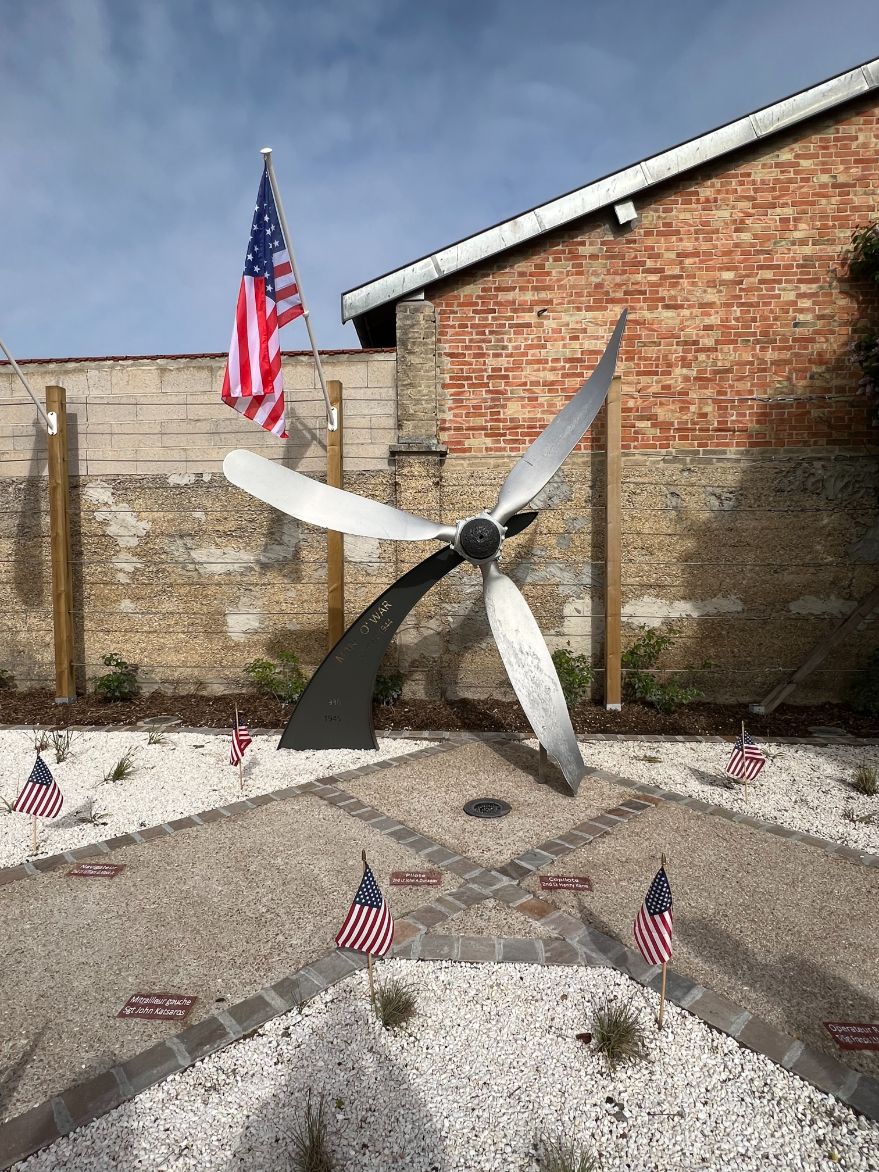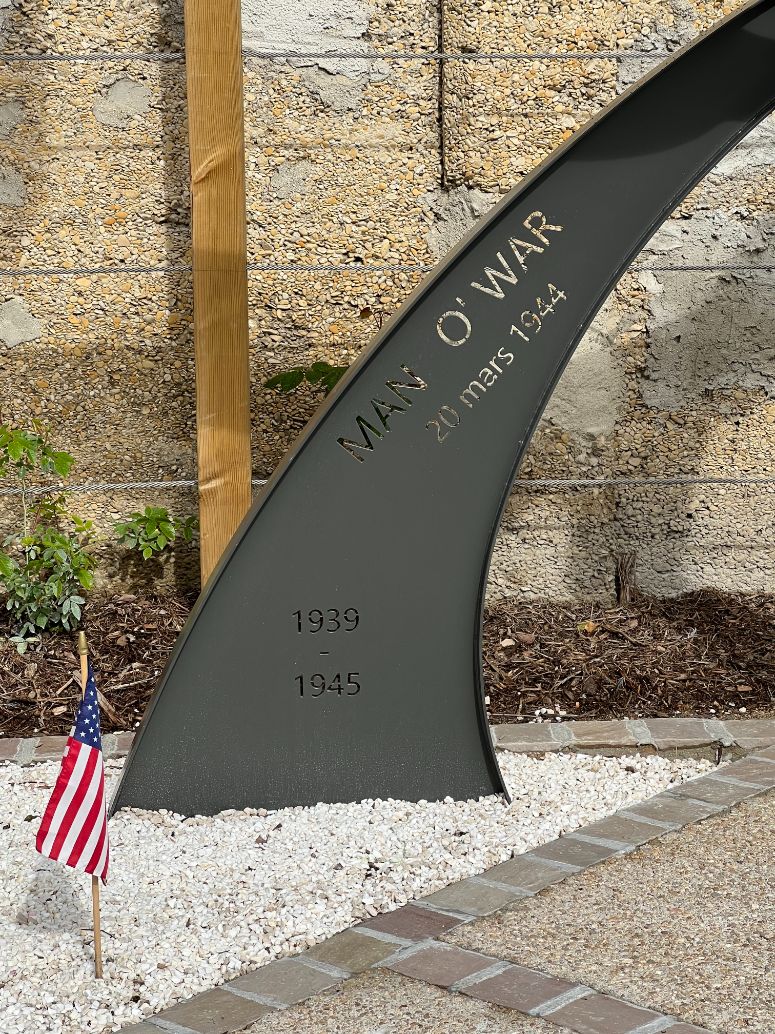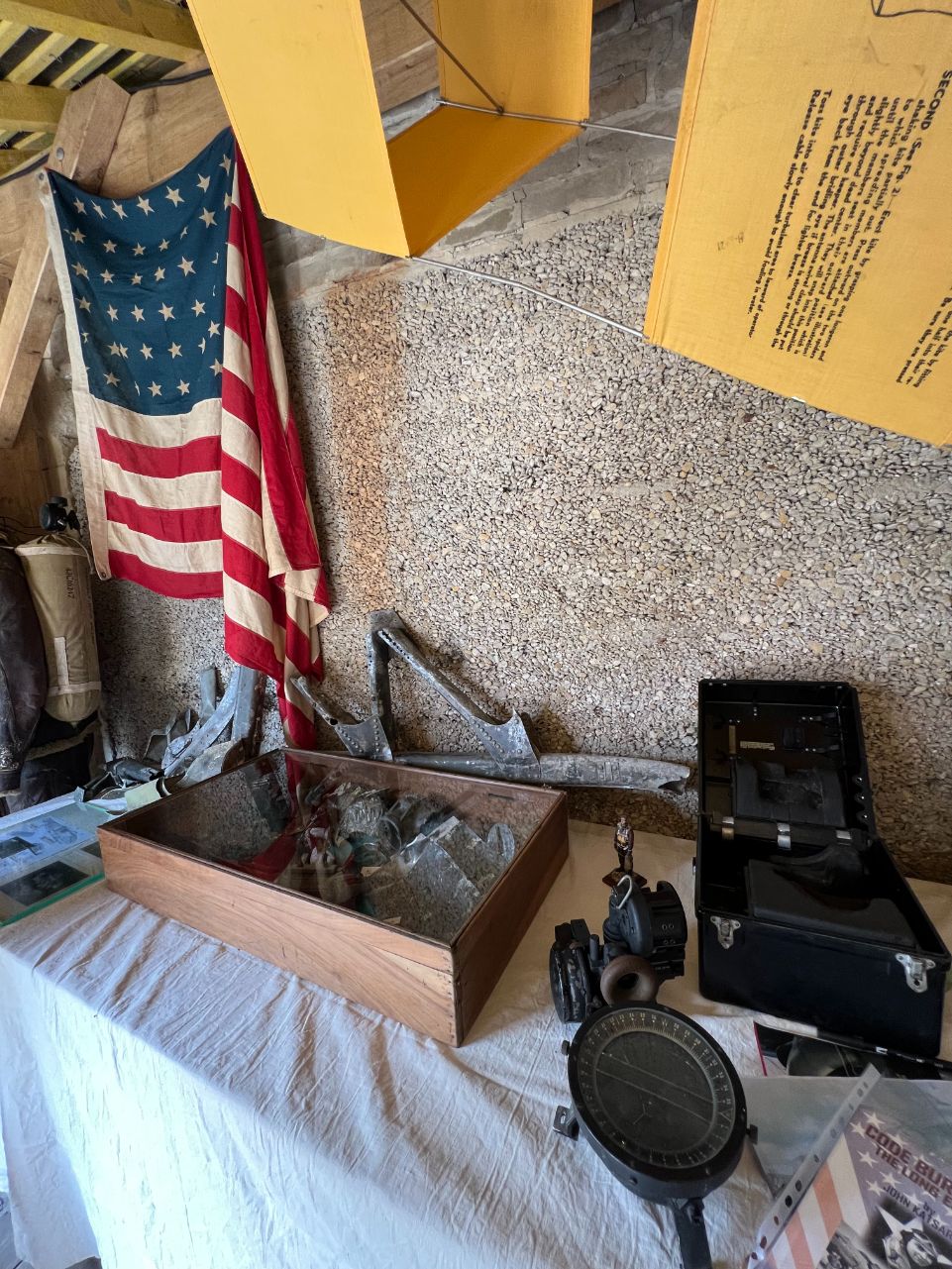B-17 'Man O’War' (42-38033) Memorial
Details:
On the west side of the road.
Monument
The memorial features the aircraft propeller mounted on a black and stylized metal support to which the name of the plane is inscribed. The Mayor of Breuil, Bertrand Boilly, planned, funded, and built the memorial to the plane and the War effort. A local historian has collected many parts from the aircraft and there is a living museum explaining all. The memorial was inaugurated on May 6, 2023.
On December 10, 1943, the B-17 "Man O' War" bomber left Newfoundland with a crew of ten for RAF Base Deenethorpe in Great Britain. It was assigned to No. 612 Squadron, 401st Bombardment Group, 8th U.S. Air Force. Between January 14 and March 19, 1944, its crew carried out nineteen raids over Germany. The aircraft was piloted by Lieutenant Dunaway. Things took a turn for the worse on March 20, 1944, when the bomber took off with part of its force on a mission to destroy the Fock Wulf factories in Frankfurt. Weather conditions were extremely poor. The aircraft had difficulty forming due to gusty winds. A collision was narrowly avoided. At this point, the "Man O' War", "Le Guerrier", lost contact with the formation and was unaware that the aircraft had been called back to base.
The bomber continued its mission alone, its crew delivering two tons of bombs to the Luftwaffe fighter factory. The target of German flak was soon intercepted by enemy fighters. The crew of the flying fortress defended themselves with all their machine guns. Tail gunner Sergeant Bentz and upper turret gunner Sergeant Horst were killed. The right-side gunner was seriously wounded in the neck. He is Sergeant Crowley. The left-side gunner, Sergeant Kalsaros, was wounded in the right arm. With the assistance of radio operator Sergeant Mastronardi, he freed the belly gunner, Sergeant Rush, who was trapped in his turret.
The bomber's right wing was in flames. Two of the four engines were curtained off. Fearing an explosion, the pilot ordered the aircraft evacuated. Soon, "Le Guerrier" flew over Breuil at a very low altitude before hitting a poplar tree and crashing into the marshes near the Vesle River. Pilot John Donaway was captured by the German army on Breuil territory and sent to a prison camp near Barth in Pomerania. He was liberated on April 30, 1945, by Red Army soldiers. His co-pilot, Lieutenant Henry Kane, was also taken prisoner not far from the crash, sent to the same camp as Donaway, and released the same day. He remained in the U.S. Air Force and was killed in action during the Cold War airlift over Berlin. Lieutenant William Mock, the navigator, was probably killed during his parachute descent by a gust of wind. His body was discovered near Courville and lies buried in the Epinal US cemetery in the Vosges. Lieutenant Theodore Krol, the bomber, landed near Coulonges-Cohan, at the junction of the Aisne and Marne departments. He fractured an ankle on landing. He was taken in by the Resistance as part of the Comète exfiltration network. He made his way to Paris, then to the maquis at the Fréteval camp in Bellande, where he arrived on June 14, 1944. The camp was overrun by American liberation forces on August 13, 1944. Sergeant Francis Mastronardi was apprehended shortly after his arrival. He was held in solitary confinement at the Reims prison, interrogated by the Gestapo, and then transferred to the Luftwaffe camp at Dulag near Frankfurt for further interrogation before being imprisoned in Pomerania. He too was liberated by the Red Army on April 30, 1945.
Sergeant Walter Rush saw his parachute hit a high-voltage power line near Unchair and fell on a palisade which punctured his stomach. A young man transferred him to a wheelbarrow for shelter in a nearby hangar, but he was found by the Germans and taken to a hospital in Reims, before being transferred to the Krems-Gneixendorf prison camp in Austria. He was released in early May 1945. The severely wounded Sergeant Crowley landed near the Bonne Maison farm near Unchair, where Great War fighter ace Captain Georges Guynemer had stayed. Captured by the Germans, he died forty-eight hours later in a hospital in Reims. Sergeant Katsaros was wounded on the landing between Courville and Magneux. He was taken in at a farm. Captured, he escaped twice, was taken in by the Resistance and crossed the border to Spain, and after many ups and downs made his way back to Great Britain. After the war, he became a recruiting officer for the US Air Force in Boston.
The book ‘The Young Ones’ by Erik Dyreborg, features stories on three of the flyers; Mastronardi, Katsaros, and Rusch.
Crew summary:
Jack Dunaway, Pilot, Bailed - POW
Henry Kane, Co-Pilot, Bailed - POW
Walter Rusch, Ball Turret Gunner, Bailed, Injured - POW
Frank Mastronardi, Radio Operator, Bailed, Injured - POW
Marvin Benz, Tail Gunner - Killed Instantly
Harry Horst, Top Turret Gunner (Replaced Sterling Nichols), Killed Instantly
William Mock, Navigator, Bailed - Body found by French Underground
John Crowley, Waist Gunner, Bailed - Died from wounds that night in a Reims hospital
John Katsaros, Waist Gunner, Bailed, Injured - Escaped and Evaded to England
Theodore Krol, Bombardier, Bailed, Injured - Escaped and Evaded, fought with Maquis, returned to England
- (His uniform was buried by the farmer who rescued him and is in the Musee de la Redition in Reims.)
Source of information: lhistoireenrafale.lunion.fr, airforceescape.org
Monument Text:
MAN O’ WAR
20 mars 1944
1939
_
1945
English translation:
MAN O’ WAR
March 20, 1944
1939
_
1945
Commemorates:
People:
Units:
401st Bomber Group
612th Bomber Squadron, 401st Bomber Group, Heavy
8th Air Force
US Army Air Corps
Wars:
WWII
Other images :



